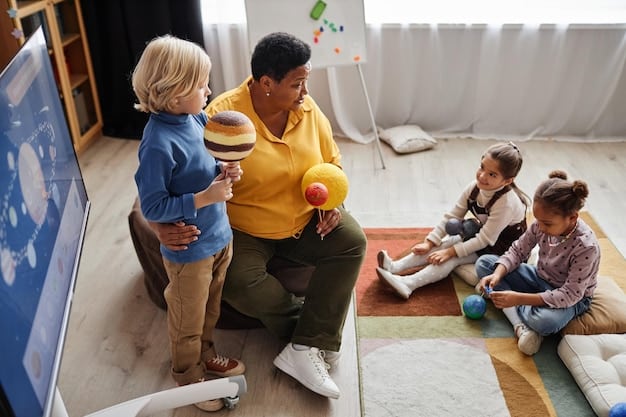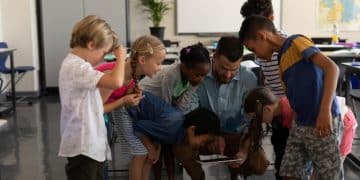IDEA Updates: How They Impact Your Child’s Education

The latest updates to the Individuals with Disabilities Education Act (IDEA) reinforce support for students with disabilities by emphasizing personalized education, early intervention, and inclusive practices, ensuring every child receives a free appropriate public education designed for their unique needs and fostering greater parental involvement in the process.
For parents of children with disabilities, navigating the educational system can be a complex journey. Understanding what are the latest updates to the Individuals with Disabilities Education Act (IDEA) and how do they impact your child’s education? is crucial. This landmark legislation ensures children with disabilities receive a free appropriate public education (FAPE), and its continuous evolution aims to enhance the support and services provided, affecting everything from individualized education programs to early intervention strategies.
Understanding the Foundations of IDEA
The Individuals with Disabilities Education Act (IDEA) is a federal law that governs how states and public agencies provide early intervention, special education, and related services to children with disabilities. Since its inception as the Education for All Handicapped Children Act in 1975, IDEA has been instrumental in guaranteeing the rights of students with disabilities and their parents. It ensures that every child, regardless of the severity of their disability, has the right to a free appropriate public education tailored to their unique needs. This foundational principle underscores the commitment to equity and access within the educational system.
IDEA is built upon six core principles that guide its implementation. These include zero reject, which means no child with a disability can be excluded from public education; FAPE, ensuring that special education and related services are provided at public expense; least restrictive environment (LRE), promoting inclusion in general education settings as much as possible; appropriate evaluation, requiring comprehensive assessments before placement; procedural safeguards, protecting the rights of parents and children; and parent and student participation in decision-making. These principles work in concert to create a supportive and legally compliant framework for special education.
The historical context of IDEA highlights a significant shift in public policy towards recognizing the educational rights of children with disabilities. Before this legislation, many children with disabilities were excluded from public schools or received inadequate educational opportunities. IDEA mandated that states provide individualized instruction and support services to meet the diverse needs of these students. This paradigm shift not only opened doors to education but also laid the groundwork for advocating for inclusive practices and challenging discriminatory barriers.
Over the years, IDEA has undergone several reauthorizations, each designed to refine the law and address emerging challenges in special education. These reauthorizations often reflect a growing understanding of best practices, advances in educational research, and societal changes. Each update aims to strengthen the provisions of the law, ensuring that it remains relevant and effective in its mission to support students with disabilities. It is a living document, constantly adapting to better serve its beneficiaries.
The impact of IDEA on special education cannot be overstated. It has revolutionized the way schools approach the education of students with disabilities, moving from a system of exclusion to one of inclusion and individualized support. Parents have become central partners in their child’s educational journey, empowered with legal rights and opportunities for participation. This collaborative approach has fostered greater accountability within the school system and improved educational outcomes for countless children across the United States.
Recent Legislative and Interpretive Changes to IDEA
While IDEA itself has not undergone a full reauthorization in recent years, there have been significant legislative and interpretive changes that influence its implementation and impact. These changes often come in the form of updated regulations, policy guidance from the Department of Education, or new state-level interpretations and laws that build upon the federal framework. Parents need to be aware of these subtle yet impactful shifts, as they can directly affect the services and supports available to their children.
One area of focus has been on refining the concept of “free appropriate public education” (FAPE). Court cases, such as Endrew F. v. Douglas County School District (2017), have provided clearer guidance on what constitutes an “appropriate” education. This Supreme Court ruling stipulated that an Individualized Education Program (IEP) must be “reasonably calculated to enable a child to make progress appropriate in light of the child’s circumstances.” This elevated standard requires schools to offer more than just a minimal education; they must provide educational benefit that is ambitious and challenging, reflecting the child’s unique potential.
There’s also been an increased emphasis on evidence-based practices and data-driven decision-making in special education. The Every Student Succeeds Act (ESSA), though not a reauthorization of IDEA, influences how states and districts support students with disabilities by integrating them into broader accountability systems. This implicitly encourages schools to use research-based interventions and collect data to monitor the effectiveness of special education services. The goal is to ensure that interventions are not only provided but are also impactful and lead to measurable progress.
Technological advancements have also spurred interpretive shifts within IDEA. How assistive technology is defined, provided, and integrated into a child’s education has seen updates to keep pace with innovation. Moreover, the increased use of distance learning and virtual education platforms, particularly amplified by recent global events, has prompted considerations about how FAPE and related services can be effectively delivered in non-traditional settings while adhering to IDEA principles. This involves ensuring equitable access to technology and appropriate virtual accommodations.
Another significant area of ongoing development relates to disciplinary practices for students with disabilities. While IDEA has always included provisions for discipline, there’s a continuous push towards restorative justice approaches and reducing the disproportionate discipline of students with disabilities. Guidance often reminds schools of their obligations to conduct manifestation determinations and to provide services during periods of suspension or expulsion, aiming to keep students engaged in their education even when disciplinary actions are necessary. These evolving interpretations are designed to ensure that disciplinary measures do not unfairly impede a child’s right to education.
States and local education agencies (LEAs) frequently issue their own guidance and regulations layered on top of federal IDEA mandates. These state-specific updates might concern specific disability categories, personnel qualifications, service delivery models, or funding. For instance, some states might have stricter requirements for teacher certification in special education or more robust early intervention programs than what is federally mandated. Parents must consult their state and local education department websites for the most current and specific information applicable to their region.
Key Changes Affecting Individualized Education Programs (IEPs)
The Individualized Education Program (IEP) is the cornerstone of special education for eligible students, outlining their educational goals, services, and supports. Recent legislative and interpretive shifts, while not always a direct rewrite of IDEA, have significantly influenced how IEPs are developed, implemented, and reviewed. These changes primarily focus on ensuring IEPs are ambitious, individualized, and effective in promoting meaningful progress for each student.
One of the most consequential impacts on IEPs stems from the Supreme Court’s ruling in Endrew F. v. Douglas County School District. This decision clarified that an IEP must be “reasonably calculated to enable a child to make progress appropriate in light of the child’s circumstances.” This moved beyond simply providing “some educational benefit” to requiring a more substantive and challenging educational program. Consequently, IEP teams are now expected to develop goals that are more ambitious and specific, reflecting a student’s potential for significant academic and functional growth. For parents, this means pushing for IEPs that truly challenge their children and help them reach their capabilities.
There is also an increased emphasis on integrating academic and functional goals within the IEP. Beyond academic achievement, IEPs are now more explicitly focused on developing critical life skills, social-emotional learning, and vocational readiness. This holistic approach recognizes that education extends beyond the classroom and encompasses a student’s overall development and preparedness for post-secondary education, employment, and independent living. IEP teams are encouraged to consider a broader range of needs and to embed these into measurable goals.
* Focus on Functional Skills: IEPs increasingly include goals related to daily living skills, social interactions, and self-advocacy.
* Transition Planning: Enhanced focus on comprehensive transition planning starting at age 16, preparing students for life after high school.
* Technology Integration: Consideration of assistive technology as a primary tool to support learning and participation.
Another development involves the procedural aspects of IEP meetings and parental involvement. While parental participation has always been central to IDEA, there’s a continuous push for more active and informed engagement from parents. This includes ensuring parents fully understand their rights, receive all necessary documentation in a timely manner, and are meaningfully involved in every step of the IEP development and review process. Some districts are adopting more collaborative meeting styles, aiming to reduce adversarial interactions and foster true partnerships between home and school.
The role of data collection and progress monitoring in IEPs has also been underscored. Schools are increasingly expected to collect consistent and reliable data on student progress towards IEP goals. This data should then be used to inform decisions about instructional strategies, services, and necessary adjustments to the IEP. For parents, understanding how this data is collected and interpreted is vital for advocating effectively for their child’s needs and ensuring the IEP remains relevant and responsive. This data-driven approach aims to make IEPs more dynamic and adaptable.
Furthermore, there is a growing recognition of the importance of mental health and social-emotional supports within IEPs. As understanding of the link between mental health and educational outcomes grows, more IEPs are incorporating related services such as counseling, psychological services, and social work services to address these needs. This broader perspective ensures that a child’s emotional well-being is considered an integral part of their overall educational success, moving beyond a purely academic focus.
The Enhanced Focus on Early Intervention and Transition Services
The latest insights and interpretive guidance related to IDEA consistently highlight the critical importance of both early intervention services for infants and toddlers and robust transition services for older students with disabilities. These two ends of the educational spectrum are recognized as pivotal for maximizing positive outcomes and promoting lifelong success. An enhanced focus on these areas reflects a proactive approach to supporting individuals with disabilities from birth through adulthood.
Early intervention services, governed by Part C of IDEA, provide crucial support to infants and toddlers (birth through age 2) with developmental delays or diagnosed conditions. Recent discussions and policy recommendations emphasize the need for accessible, comprehensive, and family-centered early intervention programs. The idea is that the earlier support is provided, the greater the potential to mitigate developmental challenges and reduce the need for more intensive services later in life. This includes services like speech therapy, physical therapy, occupational therapy, and specialized instruction delivered in natural environments.
* Increased Accessibility: Efforts to expand early intervention services to underserved populations.
* Family-Centered Approach: Stronger emphasis on empowering families as primary decision-makers and service providers.
* Inter-agency Collaboration: Encouraging greater coordination between health, social services, and educational agencies for holistic support.
On the other end, transition services, outlined in Part B of IDEA, are designed to prepare older students with disabilities for life after high school. This includes post-secondary education, employment, and independent living. Recent updates and advocacy push for transition plans within IEPs to be more individualized, concrete, and aligned with a student’s preferences and interests. The focus is on ensuring a seamless transition from the school environment to adult life, equipping students with the skills and resources needed for success.
The renewed attention to transition services also involves fostering partnerships with vocational rehabilitation agencies, higher education institutions, and community organizations. The goal is to create a network of support that extends beyond the K-12 system, providing students with practical experiences, career counseling, and opportunities for continued learning. This integrated approach helps students develop self-determination skills, identify career pathways, and access necessary accommodations in post-secondary settings.
Another aspect of the enhanced focus on early intervention and transition is the collection and analysis of data. For early intervention, states are encouraged to track child outcomes, such as social-emotional development, acquisition of knowledge and skills, and use of appropriate behaviors. For transition services, data on post-school outcomes (e.g., college enrollment, employment rates) is increasingly used to assess program effectiveness and identify areas for improvement. This data-driven approach informs policy decisions and service delivery.
The importance of addressing the specific needs of diverse populations within both early intervention and transition services has also gained traction. This includes culturally and linguistically responsive practices, ensuring that services are delivered in a way that respects a family’s background and language. Similarly, for transition, there’s a push to address disparities in post-school outcomes for students from various backgrounds, recognizing that one-size-fits-all approaches may not be adequate. This commitment to equity underscores the evolving nature of IDEA implementation.

Integrating Technology and Remote Learning Under IDEA
The rapid advancement of technology and the unforeseen necessity of widespread remote learning have prompted significant discussions and adaptations regarding how IDEA’s provisions are applied. While IDEA predates much of modern educational technology, its principles are flexible enough to accommodate these shifts. The core challenge for schools and families has been ensuring that a free appropriate public education (FAPE) can be meaningfully delivered, and all mandated services provided, regardless of the instructional setting—be it in-person, remote, or hybrid.
Assistive technology (AT) has always been a component of IDEA, defined as any item, piece of equipment, or product system, whether acquired commercially off the shelf, modified, or customized, that is used to increase, maintain, or improve functional capabilities of a child with a disability. Updates and interpretations, particularly in the wake of the digital learning surge, have broadened the understanding of what constitutes AT. This now often includes a wider array of software, apps, and digital tools that help students access curriculum, communicate, and learn effectively in virtual environments. IEP teams are now more frequently tasked with considering and providing these digital tools.
The shift to remote learning models during the pandemic highlighted both the potential and the pitfalls of delivering special education services virtually. The U.S. Department of Education consistently reminded schools that their obligations under IDEA remained intact, even in remote settings. This meant that IEPs still needed to be implemented, and FAPE provided. This often required creative solutions for delivering therapies, assessments, and individualized instruction remotely, emphasizing the need for flexibility and collaboration between schools and families.
* Virtual IEP Meetings: Increased use of teleconferencing for IEP team meetings, improving accessibility for some parents.
* Tele-therapy Services: Delivery of speech, occupational, and physical therapy via secure video platforms.
* Digital Accessible Materials: Ensuring online learning platforms and content are accessible to students using screen readers, captions, and other supports.
One of the ongoing challenges is digital equity. Not all families have reliable internet access or adequate devices, which can create significant barriers to remote learning for students with disabilities. This disparity has led to calls for greater investment in digital infrastructure and resources to ensure that the promise of FAPE is not undermined by socioeconomic factors. Schools are exploring ways to bridge this gap, supplying devices, hotspots, or alternative access methods.
The role of parents in supporting remote learning for children with disabilities has also been magnified. While parents are always vital partners, the remote environment often required them to take on more direct roles in facilitating learning and therapy at home. This has led to discussions about providing greater training and support for parents, recognizing them as essential co-educators in a virtual landscape. The collaboration between educators and families needs to be stronger than ever to overcome the unique challenges of remote service delivery.
Looking forward, the integration of technology in special education is likely to remain a prominent feature. The lessons learned from widespread remote learning are informing discussions about how technology can enhance inclusion, personalize instruction, and offer flexible learning environments for students with disabilities regardless of physical location. This focus aims to leverage technology not just as a fallback but as a proactive tool for improving educational outcomes and providing a more robust FAPE.
Discipline, Restraint, and Seclusion: Evolving Guidelines
The administration of discipline, particularly the use of restraint and seclusion, for students with disabilities under IDEA has been a perennial area of concern and has seen evolving guidelines and increased scrutiny. The fundamental principle embedded in IDEA is that disciplinary actions for students with disabilities must be addressed within the framework of their individualized education programs (IEPs) and consider their unique behavioral needs. The goal is to move away from punitive measures towards supportive interventions that address the root causes of challenging behaviors.
A key concept is the “manifestation determination review” (MDR). This process is mandated when a student with a disability faces a disciplinary action that involves a change of placement (e.g., suspension exceeding 10 days in a school year, or removal to an interim alternative educational setting). During an MDR, the IEP team, including parents, reviews the relationship between the student’s disability and the behavior in question. Recent guidance emphasizes that MDRs must be thorough, thoughtful, and genuinely consider the student’s disability and its impact on their behavior.
There is a strong push away from the use of physical restraint and seclusion in schools, particularly for students with disabilities. While not entirely prohibited by federal law, many states and local districts have adopted stricter policies, recognizing the potential for trauma, injury, and the ineffectiveness of these practices in promoting positive behavior change. The U.S. Department of Education has repeatedly issued guidance discouraging the use of these interventions, advocating for positive behavioral interventions and supports (PBIS) instead.
* Positive Behavioral Interventions and Supports (PBIS): Promoting proactive strategies to teach and reinforce positive behaviors.
* Functional Behavioral Assessments (FBAs): Emphasizing comprehensive assessments to understand the function of challenging behaviors.
* Behavior Intervention Plans (BIPs): Developing individualized plans based on FBA findings to teach replacement behaviors and provide support.
Guidance also stresses the importance of continuous educational services during disciplinary removals. Even if a student with a disability is suspended for more than 10 school days, the school is still obligated to provide services that enable the child to continue to participate in the general education curriculum and to make progress toward meeting their IEP goals. This ensures that disciplinary actions do not completely interrupt a student’s access to education.
Current trends also highlight the issue of disproportionate discipline. Data consistently show that students with disabilities, particularly minority students with disabilities, are disciplined at higher rates than their non-disabled peers. This disparity has led to increased focus on reviewing school-wide disciplinary policies, providing professional development on implicit bias, and implementing culturally responsive disciplinary practices to ensure equitable treatment for all students. The goal is to dismantle systemic biases that may contribute to these discrepancies.
The evolving guidelines also underscore the need for transparent reporting of restraint and seclusion incidents. While federal reporting requirements exist, there’s a push for greater detail and consistency in how these incidents are documented and shared, enabling better oversight and accountability. Parents are encouraged to know their rights regarding disciplinary procedures and to advocate for positive, preventative strategies that protect their child’s well-being and right to a free appropriate public education.

Addressing Systemic Issues: Equity, Access, and Accountability
Beyond the specific provisions of IDEA, there has been a growing emphasis on addressing broader systemic issues within special education, particularly concerning equity, access, and accountability. These discussions aim to ensure that the promise of IDEA translates into tangible, equitable outcomes for all students with disabilities, regardless of their background or location. This holistic approach seeks to dismantle barriers and enhance the effectiveness of the special education system as a whole.
Equity is a paramount concern, as disproportionality in identification, placement, and discipline of students from various racial, ethnic, and socioeconomic backgrounds continues to be a challenge. Federal guidance and advocacy efforts push states and districts to examine their practices to identify and address these disparities. This involves reviewing referral processes, ensuring culturally competent evaluation methods, and implementing inclusive educational practices that prevent over-identification or inappropriate placement of minority students in special education.
Access refers not only to the ability to attend school but also to accessing the full breadth of educational opportunities. This includes access to the general education curriculum, extracurricular activities, advanced coursework, and highly qualified teachers. Recent discussions emphasize ensuring that students with disabilities are truly included in mainstream educational settings whenever appropriate, and that they receive the necessary accommodations and modifications to thrive alongside their non-disabled peers. This reinforces the principle of the least restrictive environment (LRE).
Accountability under IDEA has become more nuanced. While schools are always accountable for providing FAPE, there’s an increased focus on measurable student outcomes and the effective use of resources. This involves:
* Data-Driven Decision Making: Using comprehensive data to evaluate the effectiveness of special education programs and interventions.
* Monitoring and Compliance: Federal and state agencies are enhancing their oversight to ensure districts comply with IDEA regulations.
* Parental and Student Voice: Increasing mechanisms for feedback from families and students to hold schools accountable for quality services.
Funding for special education remains a continuous point of discussion. While IDEA outlines federal mandates, the actual funding provided by the federal government has historically fallen short of the promised levels, placing significant financial burdens on states and local districts. Advocacy groups consistently call for full federal funding to ensure that schools have the resources necessary to implement IDEA effectively and provide high-quality services without compromising other educational programs.
The COVID-19 pandemic also illuminated systemic vulnerabilities regarding access to education for students with disabilities, particularly in remote learning environments. Issues of digital divide, limited access to related services, and challenges in maintaining consistent IEP implementation became apparent. This has prompted ongoing conversations about building more resilient and equitable educational systems that can adapt to unforeseen circumstances while still upholding the rights of students with disabilities.
Ultimately, addressing systemic issues under IDEA requires a collaborative effort from policymakers, educators, families, and communities. It involves continuous review of practices, investment in professional development for educators, and a commitment to fostering inclusive environments where every child, regardless of disability, has the opportunity to achieve their full potential. This broader lens on equity, access, and accountability is essential for the continued evolution and success of IDEA.
Advocating for Your Child: Tools and Strategies for Parents
Understanding the latest updates to IDEA is crucial, but knowing how to effectively advocate for your child within this framework is equally important. Parents are central to the special education process, serving as their child’s primary champions and ensuring their rights under IDEA are upheld. Equipping yourself with the right tools and strategies can make a significant difference in securing the appropriate educational services and supports for your child.
The first and most fundamental tool for parents is knowledge. Familiarize yourself with the core principles of IDEA, your parental rights (procedural safeguards), and the specifics of your state and local special education policies. Resources like the U.S. Department of Education’s IDEA website, parent training and information centers (PTIs), and disability advocacy organizations offer a wealth of information. Understanding the language of IEPs, evaluations, and specific services will empower you to participate meaningfully in discussions.
Effective communication is another vital strategy. Foster a collaborative relationship with the school team, recognizing that you are all working towards the common goal of your child’s success. Document all communications—keep a detailed log of phone calls, emails, and meetings. During IEP meetings, be prepared to share your insights into your child’s strengths, needs, and learning style. Don’t hesitate to ask questions for clarification or to request explanations in plain language, advocating for your child’s unique circumstances.
* Requesting Evaluations: Parents have the right to request an evaluation if they suspect their child has a disability.
* Reviewing Records: Parents have the right to inspect and review all educational records related to their child.
* IEP Meeting Participation: Actively participate in all IEP meetings, bringing relevant information and questions.
Learn the art of active listening and assertive communication. During IEP meetings, listen carefully to the perspectives of all team members, but also be prepared to assert your child’s needs and your concerns. It’s helpful to prioritize your key concerns before the meeting and to present them clearly and calmly. If you disagree with a proposal or decision, calmly state your reasons and suggest alternatives. Bring a trusted friend, family member, or advocate to meetings for support and to take notes.
Understanding the “Stay Put” rule is a powerful advocacy tool. If you formally disagree with a proposed change in your child’s placement or services, the “Stay Put” provision generally means your child continues to receive services and placement as outlined in the *previous* agreed-upon IEP, pending resolution of the dispute. This prevents unilateral changes by the school during a disagreement and provides stability for your child amidst procedural complexities.
Finally, know when and how to seek external help. If disagreements with the school cannot be resolved informally, IDEA provides various dispute resolution mechanisms, including mediation, due process hearings, and state complaint procedures. While these can be daunting, parent training and information centers (PTIs) or legal aid services specializing in special education can offer guidance and direct support. Remember, advocating effectively is an ongoing process that often requires persistence, patience, and a deep commitment to your child’s educational future.
The Future of Special Education Under IDEA: What to Expect
The landscape of special education under IDEA is dynamic, continuously evolving to meet the changing needs of students with disabilities and reflect best practices. Looking ahead, several trends and areas of focus are likely to shape the future direction of IDEA and its implementation. These anticipated developments will further refine how services are delivered, how outcomes are measured, and how technology is integrated to enhance the educational experience for all.
One significant trend will likely be the increased emphasis on personalized learning within the special education framework. While IEPs are inherently individualized, future approaches may leverage technology and data analytics to tailor instruction even more precisely to a student’s unique learning style, pace, and preferences. This could involve adaptive learning software, virtual reality for skill development, and AI-powered tools that provide real-time feedback to both students and educators. The goal is to maximize engagement and optimize learning pathways for diverse learners.
The focus on mental health and social-emotional well-being is expected to grow substantially. As the understanding of the intertwined nature of mental health and academic success deepens, IEPs and school-wide support systems will likely incorporate even more robust provisions for psychological services, counseling, and social-emotional learning interventions. This holistic approach aims to address the emotional and psychological needs that can significantly impact a student’s ability to learn and thrive in school.
* Trauma-Informed Practices: Greater adoption of approaches that recognize and respond to the impact of trauma on learning and behavior.
* Whole-Child Approach: Moving beyond academic metrics to encompass social, emotional, and physical well-being.
* Increased Collaboration: Stronger partnerships with mental health professionals and community services.
Another area of anticipated growth is in the transition from school to post-secondary life. As the workforce evolves, there will be a continued need to ensure students with disabilities are equipped with relevant vocational skills, career readiness training, and self-advocacy abilities. This may involve more sophisticated partnerships with employers, enhanced internship opportunities, and innovative programs that bridge the gap between academic learning and independent living. The goal is to ensure meaningful employment and social inclusion.
Data interoperability and the use of big data in special education are also likely to expand. The ability to seamlessly share and analyze data across different systems (e.g., educational, health, social services) could provide a more comprehensive picture of a student’s needs and progress. This could lead to more proactive interventions, better resource allocation, and a clearer understanding of program effectiveness at both the individual and systemic levels. However, this also raises important considerations regarding data privacy and security.
Finally, an ongoing push for increased professional development for educators will be paramount. As research into neuroscience and effective pedagogical practices for students with disabilities continues to advance, general education and special education teachers will need ongoing training to implement evidence-based strategies, utilize new technologies, and foster inclusive classroom environments effectively. This commitment to continuous learning will be crucial for translating IDEA’s mandates into high-quality educational experiences for every child.
| Key Aspect | Brief Impact |
|---|---|
| 🎯 IEP Ambition | Requires IEPs to aim for significant, challenging progress, not just minimal benefit. |
| temprana Early Intervention | Increased focus on birth-to-age-2 services for better long-term outcomes. |
| 💻 Tech Integration | Broader interpretation of assistive tech; guidance for remote learning delivery. |
| ⚖️ Discipline Trends | Shift towards positive behavioral supports; reduced reliance on restraint/seclusion. |
Frequently Asked Questions About IDEA Updates
FAPE, under the clarified IDEA, means your child’s education must be “reasonably calculated to enable a child to make progress appropriate in light of the child’s circumstances.” This implies a higher standard, requiring IEPs to offer more than just minimal benefit. The education should be ambitious, challenging your child to make meaningful progress towards their unique potential, tailored to their individual needs and capabilities.
The Endrew F. v. Douglas County School District case established that an IEP must be “reasonably calculated to enable a child to make progress appropriate in light of the child’s circumstances.” This means IEP goals should be ambitious and challenging, designed to help your child achieve significant academic and functional growth, not just provide a basic education. It empowers parents to advocate for more substantive IEPs.
While IDEA obligations remain, recent interpretations clarify how FAPE applies remotely. Schools must provide necessary assistive technology (e.g., software, devices) and deliver services (like tele-therapy or virtual instruction) outlined in the IEP. The focus is on ensuring equitable access to online platforms and accessible digital materials, along with increased communication and collaboration between schools and parents to navigate virtual environments effectively.
Yes, there’s an increased emphasis on positive behavioral interventions and supports (PBIS) and a reduction in the use of restraint and seclusion. Schools must conduct thorough manifestation determination reviews (MDRs) if disciplinary actions result in a change of placement, linking behavior to disability. Students must also continue to receive educational services during periods of suspension or removal, ensuring their learning isn’t interrupted.
To advocate effectively, stay informed about IDEA and state/local policies. Maintain open and documented communication with the school team. Actively participate in IEP meetings, asking questions and asserting your child’s needs. Understand your procedural safeguards, including the “Stay Put” rule. Don’t hesitate to seek support from parent training centers or disability advocacy groups if you encounter unresolved disagreements with the school.
Conclusion
The Individuals with Disabilities Education Act (IDEA) continues to serve as the bedrock for ensuring that children with disabilities receive the education and support they deserve. While major legislative overhauls are infrequent, the continuous stream of interpretive changes, judicial rulings, and evolving best practices directly impacts how IDEA is implemented. Parents who stay informed about these updates are better equipped to navigate the special education system, assert their children’s rights, and collaborate effectively with schools. The pursuit of an equitable, individualized, and effective education for every child with a disability remains the core mission, and ongoing vigilance and advocacy are key to transforming policy into positive outcomes.





